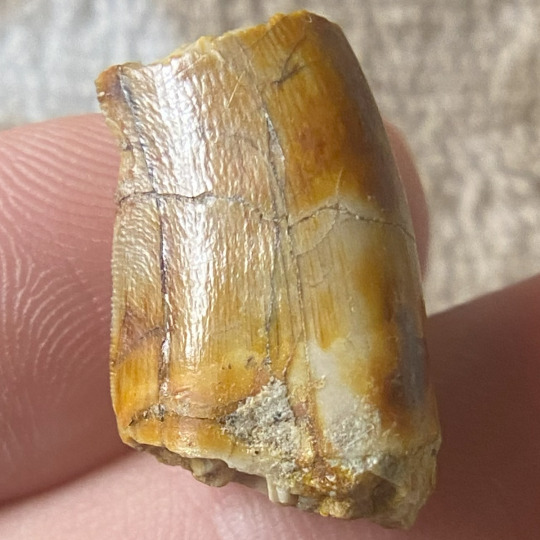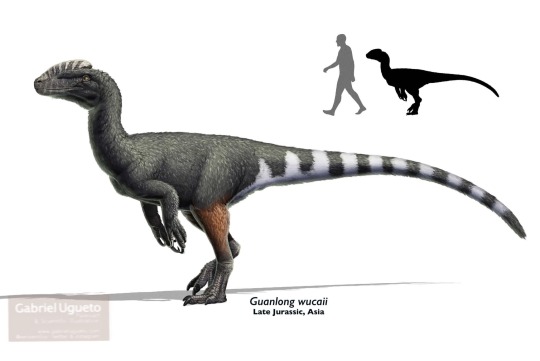#proceratosauridae
Explore tagged Tumblr posts
Text

Portrait of Guanlong wucaii, an Asian proceratosaurid and an ancient, distant relative of the infamous Tyrannosaurus that lived about 160 million years ago in the Late Jurassic of what is now the Shishugou Formation of Western China.
#paleoart#dinosaur#dinosaurs#paleontology#paleoillustration#paleoblr#palaeoblr#palaeontology#palaeoart#guanlong#dinosaur artwork#dinosaur art#jurassic period#jurassic#theropods#theropoda#theropod#theropod dinosaur#theropod dinosaurs#mesozoic#coelurosaur#coelurosaurs#proceratosauridae#proceratosaurids#palaeoillustration#paleoartists on tumblr#paleoartist#artists on tumblr#dinosauria#jurassic dinosaur
108 notes
·
View notes
Text

A partial dinosaur tooth of an indeterminate theropod from an unknown locale. It was labeled as possibly from the Yixian Formation thus potentially Yutyrannus huali. However, the odd orange preservation does not match that of this deposit according to those familiar with the formation; I'm also not sure if that darkened spot was caused by fire damage. The distal serration density of 20-21/5mm seems a bit high for Yutyrannus based on what's described from Sinotyrannus which is around 15-16/5mm, and it's unclear whether the tooth has a mesial carinae. There is a possibility that it belongs to the Cretaceous carcharodontosaurian tooth taxon, Prodeinodon. A very unusual tooth, but unfortunately the dubious provenance makes identification extremely difficult if not impossible.
#dinosaur#fossils#paleontology#palaeontology#paleo#palaeo#yutyrannus#prodeinodon#proceratosauridae#tyrannosauridae#carcharodontosauridae#theropod#cretaceous#mesozoic#prehistoric#science#paleoblr#ユウティラヌス#プロデイノドン#プロケラトサウルス科#ティラノサウルス科#カルカロドントサウルス科#恐竜#化石#古生物学
58 notes
·
View notes
Text

The tyrannosauroid Kileskus aristotocus eats a baby mamenchisaurid sauropod. The Middle Jurassic (Bathonian age) of the future Krasnoyarsk region, Russia.
I started this work as a sketch for a challenge with friends, but eventually made a detailed drawing imitating the style of a gel ink pen. I must say that it is more convenient to draw with a real gel pen. But still, this work gave me a good experience. :) Kileskus was a medium-sized theropod, close to the English Proceratosaurus and the Chinese Guanlong. It is known from a partial maxilla, a piece of the back of the jaw, and several postcranial fragments. Mamenchisaurid sauropods from the Berezovsk coal mine were described in 2019 from isolated teeth and tail vertebrae with characteristic features for this group (link.springer.com/article/10.1… -..). Due to the fragmentary nature of the material, a new taxon was not isolated, but the Krasnoyarsk region mamenchisaurid is important as the northernmost representative of its family.
Paint Tool Sai 2.0, 2024.
#kileskus aristotocus#kileskus#proceratosaurus#guanlong#proceratosauridae#tyrannosaurus#tyrannosauridae#tyrannosauroidea#theropod dinosaur#mamenchisauridae#dinosaurs of Russia#russia#paleoart
4 notes
·
View notes
Text
I don't think I posted this one here, and I can't be bothered to check. This one's about a domesticated proceratosaur having an experience.
#gondolend#dinopunk#proceratosauridae#althirhinus#notosuchia#writing#my witing#fiction#fantasy writing#short fiction#short stories#dinosaurs
0 notes
Text

"...THE SKULL AND PELVIS PLACE IT IN THE TYRANNOSAUROID SUPERFAMILY. LIKE MANY OTHER THEROPODS, IT ALMOST CERTAINLY HAD FEATHERS."
PIC INFO: Resolution at 1387x1387x1913 -- Spotlight on the Guanlong wucaii, a small to mid-sized early tyrannosaur and a member of the family Proceratosauridae. Unlike your typical tyrannosaur, Guanlong wucaii had long arms and three-fingered hands for grabbing and ripping. But the shape of its teeth, and features in the skull and pelvis place it in the tyrannosauroid superfamily. Like many other theropods, it almost certainly had feathers. Artwork by William Stout, c. 2009.
Genus: Guanlong
Species: wucaii
Family: Proceratosauridae
Super Family: Tyrannosauroidea
Suborder: Theropoda
Order: Saurischia
Superorder: Dinosauria
Class: Reptilia
Subphylum: Vertebrata
Phylum: Chordata
Kingdom: Animalia
Pronounced GWON-long woo-kay-eye
INTRODUCTION: "Named from the Chinese words guan, meaning "crown," and long, meaning "dragon," in reference to its flashy head-crest, the most elaborate of any known theropod dinosaur. The species name comes from the Chinese word wucai meaning "five colours" and refers to the multi-hued rocks at Wucaiwan, the badlands where the fossils were found.
Guanlong wucaii is one of the most primitive tyrannosaurs known. It hunted its prey 95 million years before T. rex lived."
-- AUSTRALIAN MUSEUM, Dinosaurs and their Relatives/Dinosaur Fact Sheets
Source: www.pinterest.com/pin/504614333230272954 & https://australian.museum/learn/dinosaurs/fact-sheets/guanlong-wucaii.
#Guanlong#Guanlong Crowned Dragon#Palaeo Art#Dinosaur Art#Dino Art#William Stout#Feathered Dinosaur#Tyrannosauroid#Theropod#Dinosaur#Feathered Dinosaurs#Guanlong Wucaii#Dinosaurs#Wucaiwan#Tyrannosaur#Watercolors#Prehistoric Art#Prehistoric#Prehistory#Palaeo Artist#Illustration#William Stout Artist#Crowned Dragon#Dinos#Crowned Dragon Guanlong#Tyrannosauroid Superfamily#Animals#Prehistoric Animals#Prehistoric Life
2 notes
·
View notes
Photo

Portrait of Kileskus aristotocus, a Proceratosaurid from Middle Jurassic Russia. Done in oils on a pre-painted canvas in one night, based on one of the Valentine's cards I drew for my coworkers, 2020 On Reddit I had to upload this as a jpeg for file size reasons, but at least it could retain its full dimensions. So here’s a link to that, for your zooming pleasure: https://old.reddit.com/r/Paleoart/comments/gvauzb/portrait_of_kileskus_aristotocus_a/
#Kileskus#Russian prehistory#Proceratosauridae#Middle Jurassic Period#Thereopods#feathered dinosaurs#paleoart#paleoillustration#oil painting#canvas#animal portraiture#dinosaur#finished piece#quick painting#reddit link#Christopher Maida Artwork
56 notes
·
View notes
Photo


Work in progress on my Yutyrannus huali, color reference included. This time I'm pulling from the Bearded Vulture, an amazing bird with some fuzzy looking feathers and great colors.
#workinprogress#yutyrannus#dinosaur#cretaceous#tyrannosaur#theropod#proceratosauridae#wip#paleontology#paleo#paleoart#extinctanimal#extinction#educational#science#sciart#naturalhistory#digitalart#digitalillustration#illustration#painting#drawing#maine#maineart#newengland#artistsontumblr
141 notes
·
View notes
Link
3 notes
·
View notes
Photo


102 notes
·
View notes
Text

Day 10: Guanlong wucaii
That night, a proceratosaurid Guanlong glowing it own black filamentous with blue Bioluminescent.
#my art#dinosaur#dinosaurs#paleoart#dinosauria#ornithoscelida#theropoda#avetheropoda#coelurosauria#tyrannoraptora#tyrannosauroidae#proceratosauridae#guanlong#procreate5x#procreate#dinovember#draw dinovember
0 notes
Text
Dinofact #40
Proceratosaurus, a small theropod carnivore, was originally thought to be an ancestor of Ceratosaurus, due to the crest on its head resembling that of Ceratosaurus. However, it is now considered a coelurosaur, specifically a member of Proceratosauridae, whereas Ceratosaurus is a Ceratosaurid. Proceratosaurus may be one of the earliest members of Tyrannosauroidea.
Source: wikipedia [1], [2]
#dinosaur#dinosaurs#paleontology#proceratosaurus#ceratosaurus#theropod#theropods#theropoda#coelurosaur#coelurosaurid#coelurosauria#tyrannosaur#tyrannosauroidea#tyrannosauroids#tyrannosauroid#ceratosaurid#ceratosaurids#ceratosauridae#ceratosauria#fun facts#trivia#dinosaur trivia#dinosaur fun facts#3rd#october#2022#october 3rd#october 2022#october 3rd 2022
8 notes
·
View notes
Text
Guanlong wucaii
('crown dragon, multicoloured/five-coloured')
Tyrannosauroidea Proceratosauridae*
The 'multicoloured' or 'five-coloured' of the species name refers to the rainbow rocks the two specimens were found in, stacked one atop t'other, with some other little animals thrown in--even another proceratosaurid, Dilong paradoxus. All these animals were literally squished and drowned inside the big chowder pot of a giant sauropod footprint. Tragic event for them = really cool fossil for us.
Shishugou Formation, Dzungaria, Xinjiang, China.
Upper Jurassic, ~160 Ma.
*Proceratosaurids were once thought to be ancestral to ceratosaurs; now understood to be tyrannosauroids
~
Artwork by Gabriel Ugueto.

Daily Dino Fact #45
8 notes
·
View notes
Text

A dinosaur tooth of an indeterminate tyrannosauroid, possibly cf. Yutyrannus huali or some other undescribed tyrannosaur from the Jehol Group in Beipiao, Liaoning, China. The tooth has a midline mesial serration density of 18/5mm and distal serration density of 18-19/5mm; the crown height is 30.5mm, CBL of 13mm, and CBW of 6.6mm. The mesial carinae extends around 2/3 the way down and does not reach the base. Near the upper half of the crown, there are three faint striations near the anterior side of the tooth. It's unclear if this is a pathology or a potentially diagnostic characteristic. While such features are not described from Yutyrannus, they are known from other basal tyrannosauroids like Proceratosaurus bradleyi and Dilong paradoxus. The closest relative of Yutyrannus, Sinotyrannus kazuoensis from the Jiufotang Formation has a serration density of around 15-16/5mm while this tooth has something more similar to that of pantyrannosaur, Timurlengia eurotica from the Bissekty Formation of Uzbekistan. Though the serration density may be too high based on its closest relative, the DSDI of around 1.0 is at least consistent with Yutyrannus. While it is possible this could be a Bissekty Timurlengia, it doesn't seem likely based on the matrix.
#dinosaur#fossils#paleontology#palaeontology#paleo#palaeo#yutyrannus#proceratosauridae#tyrannosauridae#theropod#cretaceous#mesozoic#prehistoric#science#paleoblr#fossil friday#fossilfriday#ユウティラヌス#ティラノサウルス科#恐竜#化石#古生物学
8 notes
·
View notes
Note
Everyone praises Tyrannosaurus for its' strong bite force; a bite so powerful it could puncture and/or crush bone. But was Tyrannosaurus the only member of its' Clade (Tyrannosauroidea) capable of such a bite? Were its' relatives (Proceratosauridae, Albertosaurinae, Alioramini, other Tyrannosaurinae, other Tyrannosauroidea, etc.) also capable of such a powerful bite? If so, what's the earliest this trait would've appeared in the Tyrannosauroidea Clade?
Tyrannosaurus most likely had the strongest bite of all known tyrannosauroids, in part because it was the biggest one. However, specializations for a powerful crushing bite are seen in essentially all tyrannosaurids (at least as adults). These adaptations include a deep, wide skull, thickened teeth with deep roots, and reinforced bones in the snout and palate. Numerical estimates of bite force consistently find that tyrannosaurids likely had stronger bites than similarly-sized ceratosaurs and allosauroids.
Many non-tyrannosaurid tyrannosauroids had some of the aforementioned features, but they generally did not have the full suite. I don’t recall any quantitative estimates of their bite force offhand, but I’d expect from their anatomy that they mostly had bite forces similar to those of other carnivorous theropods in the same size range. Mind you, the bites of many non-tyrannosaurid theropods were quite capable of puncturing and scraping bones; it’s more that they probably weren’t crunching through large quantities of bone on a regular basis the way tyrannosaurids appear to have done.
7 notes
·
View notes
Text
Another one for our dino challenge with my friend @akire2002 ! (Randomly generated dinosaur + randomly generated colour palette)



About GUANLONG:
name meaning: "crowned dragon" (very fancy name for a very fancy dinosaur hehe)
time period: Late Jurassic
family: proceratosauridae
interesting facts: Guanlong is a relative of a well known Tyrannosaurus. Crests on their head were for mating display. (Those little chicks in my drawing are wrong. Younglings probably didn't have them at that age)
Check out my other dinosaurs from this challenge:
Parvicursor
Khaan & Kaatedocus
#dinosaur#digital art#my artwork#challenge#drawing challenge#art#original character#artwork#character art#digital illustration#guanlong#theropod#randomly generated
6 notes
·
View notes
Text
New favorite pass time while at work is going through Wikipedia trying to draw every single dinosaur. Going from Clade (currently doing theropoda) down to superfamily, then from there into subgroups, into genus, and then into species. Currently have done the subgroups Tyrannosauridae, tanycolagreus(poor baby all by itself), and proceratosauridae. This method is efficient as I can be but I’m probably still missing a whole lot! Cause the tyrannosauroidae super family doesn’t have the tyrannosauridae listed under it for some reason! Even though they belong to that group and it says it on their page! And Wikipedia does this with like every other thing too!!! I only know like a couple hundred off the top of my head please what am I gonna do when I run out of them to search?? I’ll just have to spend forever digging on Wikipedia trying to find them
1 note
·
View note